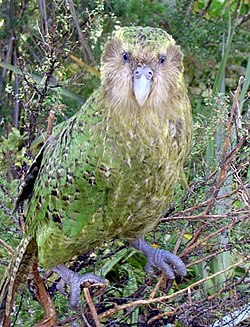Kākāpō
| Kakapo | |
|---|---|
 |
|
| A male named Sirocco on Maud Island | |
| Scientific classification | |
| Kingdom: | Animalia |
| Phylum: | Chordata |
| Class: | Aves |
| Order: | Psittaciformes |
| Family: | Strigopidae |
| Genus: |
Strigops G.R. Gray, 1845 |
| Species: | S. habroptilus |
| Binomial name | |
|
Strigops habroptilus G.R. Gray, 1845 |
|
The kakapo (Māori: kākāpō or night parrot), Strigops habroptilus (Gray, 1845), also called owl parrot, is a species of large, flightless, nocturnal, ground-dwelling parrot of the super-family Strigopoidea endemic to New Zealand.
It has finely blotched yellow-green plumage, a distinct facial disc of sensory, vibrissa-like feathers, a large grey beak, short legs, large feet, and wings and a tail of relatively short length. A combination of traits make it unique among its kind; it is the world's only flightless parrot, the heaviest parrot, nocturnal, herbivorous, visibly sexually dimorphic in body size, has a low basal metabolic rate and no male parental care, and is the only parrot to have a polygynous lek breeding system. It is also possibly one of the world's longest-living birds. Its anatomy typifies the tendency of bird evolution on oceanic islands, with few predators and abundant food: a generally robust physique, with accretion of thermodynamic efficiency at the expense of flight abilities, reduced wing muscles, and a diminished keel on the sternum. Like many other New Zealand bird species, the kakapo was historically important to the Māori, the indigenous people of New Zealand, appearing in many of their traditional legends and folklore. It was hunted and used as a resource by Māori, both for its meat as a food source and for its feathers, which were used to make highly valued pieces of clothing. It was also sometimes kept as a pet.
The kakapo is critically endangered; as of June 2016, the total known adult population was 154living individuals, as reported by the Kakapo Recovery programme, most of which have been given names. Because of Polynesian and European colonisation and the introduction of predators such as cats, rats, ferrets, and stoats, the kakapo was almost wiped out. Conservation efforts began in the 1890s, but they were not very successful until the implementation of the Kakapo Recovery plan in the 1980s. As of April 2012, surviving kakapo are kept on three predator-free islands, Codfish (Whenua Hou), Anchor and Little Barrier islands, where they are closely monitored. Two large Fiordland islands, Resolution and Secretary, have been the subject of large-scale ecological restoration activities to prepare self-sustaining ecosystems with suitable habitat for the kakapo. The New Zealand government is providing the use of these islands to kakapo conservation.
...
Wikipedia

